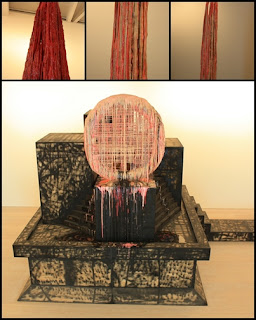For more info write up on the article direct link to this page : http://www.timeoutkl.com/art/articles/Art-tasting
*Article were taken from timeout kl magazine december 2010 issue:
Art tasting
December 2010
Art tasting
Solo exhibitions tend to steal the headlines and grab all the attention in the art circles. Big names guarantee higher audience numbers and a better reaping for art galleries. The audience loves the anticipation of seeing what’s fresh-off-the-line from the artist’s studio. But one type of show that still makes quiet ripples in the scene that features on almost every commercial gallery’s exhibition schedule is the mixed show.
Of more democratic proportions, this type of exhibition is exactly as its title suggests: it’s a mixed bag. No two artworks are the same and the participating artists often differ just as much.
Whilst cynics may argue that these shows function as ‘fillers’ and are therefore not as noteworthy as those with more tangible focus, mixed group shows have their merits and still prove to be a challenge for galleries to mount.
Raja Annuar of Pelita Hati House of Art, for one, dismisses their triviality, arguing that they ‘can be more difficult’ to organise. ‘First, we need to select artists, then select good artworks and ensure that the artworks come in on time. Another challenge is actually putting them all together in such a way that each piece stands out. And at the same time when put together, they complement each other. Finally, we need to promote the exhibition so that people will be interested enough to come and view.’
Hard work indeed. Still, there are payoffs for fishing out new talents and trying to kindle new movements in art.
‘Ever since we started the gallery in 1995, we’ve focused on promoting young and emerging artists and are continuously looking out for new talents and artworks using new media. We have been rather daring in doing this and have even showcased experimental and installation art, which is not what other commercial galleries are keen on doing. I must say we have done this rather well and works of young and emerging artists have caught the interest of many. The outcome is that today many galleries are doing what we started, that is showcasing young and emerging artists,’ he says.
Fair claims and there’s also no denying that mixed group exhibitions allow less established talents to get their foot in the door. The pros for audiences are multifold too. Avid gallery-goers get to see a bundle of artists in one go and fresh faces can reasonably gauge the flavour of contemporaneous art practices.
In the case of Pelita Hati House of Art’s ‘Open Show’ later this month, that’s about 40 different flavours (or artworks) to be precise. The gallery’s submission guidelines for the exhibition guarantee this and Raja Annuar states that no theme, size or medium was indicated. ‘We did not want to limit the creativity of participants. However, we did assess and screen all submissions,’ he says.
As audience members, expect anything and everything at the Bangsar-based gallery this month. A quick look at some of the artworks confirms the promise of this diversity with a seascape by Adrian Ho (an oil on canvas titled ‘Northern Tip of Borneo 1’), a trippy digital image by Nur Asyikin Abdul Razak featuring iconic sixties model Twiggy, and even video art in the fray.
Raja Annuar’s explanations for some of the selections are as divergent. On Azizul Hakim’s beguiling silkscreen of a child standing amidst conditions of war, he says, ‘We have not been given any story behind this piece but the look of the boy in the artwork – that is something that we really want to know.’ And Ahmad Hisyamuddin Abdullah’s linocut titled ‘Bapa’ made the cut because of the rarity of the medium (‘There are not many artists who want to do prints nowadays, but to us we still think this sort of artwork can be popular and have quite a good potential for the art market’).
‘Art galleries do to a certain extent dictate and create a new wave in the art scene. Galleries promote works, and the works that are more aggressively promoted will of course get more exposure. Works that galleries promote are viewed as works that have achieved a certain standard and can set a trend in its popularity. These in turn influence the type of artworks produced by other artists,’ continues Raja Annuar, incidentally giving props to exhibitions like this.
Do the works in the Open Show reflect our local art scene? ‘Yes I suppose it will indirectly reflect the current trends in Malaysian art, although this was not included specifically as a selection criterion,’ he argues.
Great answer but it doesn’t quite hit the nail on the head. Where exactly does a mixed exhibition like Pelita Hati’s ‘Open Show’ fit in? Will it be further proof that contemporary Malaysian art is still struggling to find itself a definitive voice? Or, will it simply be a case of art mirroring our society – that it is diverse, heterogeneous and well, just a little bit unpredictable?
I’m placing my bet on the latter. Mixed exhibitions make a great change in the yearly exhibition route and Pelita Hati’s ‘Open Show’ this month may just give us a lot more to look forward to in the new year.
Article from: TOKL Dec Issue
*thanks to:pelita hati gallery and also time out kl magazine




























